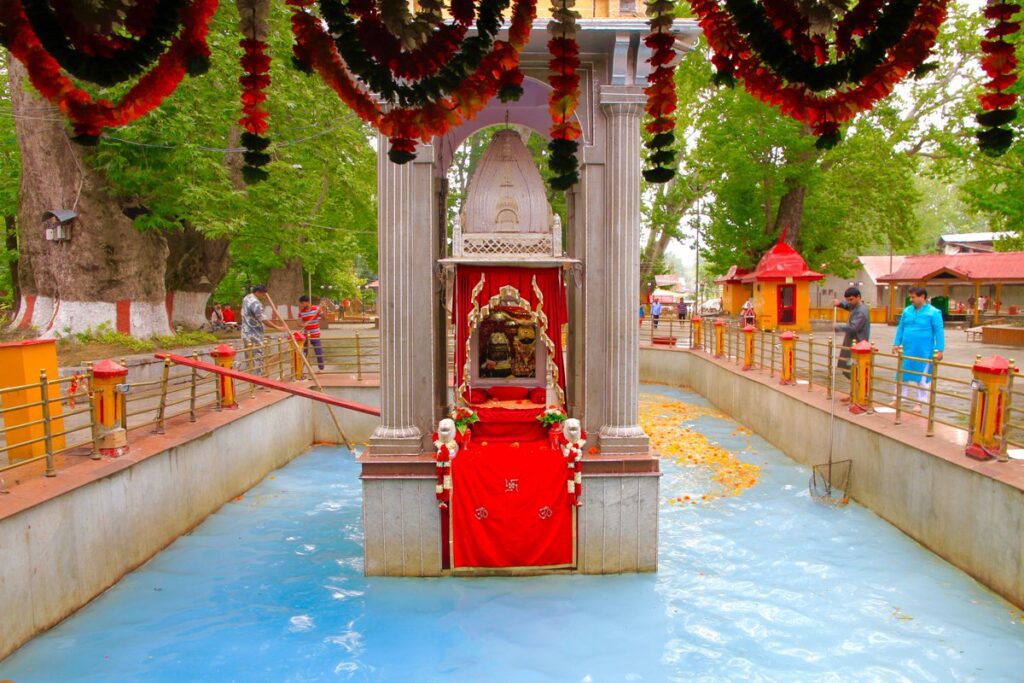Kheer Bhawani, Ksheer Bhawani or the Ragnya Devi temple is a Hindu temple situated at a distance of 25 kilometres (16 mi) north-east of Srinagar, Jammu and Kashmir, India, in the village of Tulmul in Ganderbal. It is dedicated to the Hindu goddess Kheer Bhavani constructed over a sacred spring. As is the custom with Hindu deities, the goddess has many names including Ragnya or Rajna, along with variations in honorifics such as Devi, Mata or Bhagavati. The term kheer refers to a milk and rice pudding that is offered to propitiate the goddess. Kheer Bhawani is sometimes translated as ‘Milk Goddess’. The worship of Kheer Bhawani is universal among the Hindus of Kashmir, most of them who worship her as their protective patron deity Kuladevi.
The sacred spring here has its own attached belief. An eponymously named mela is held annually here. It is one of the largest gatherings of Hindus in the region following the Amarnath pilgrimage. Maharaja Pratap Singh of Jammu and Kashmir and Maharaja Hari Singh contributed to building and renovating the temple.
There are other temples to Kheer Bhawani in the region, such as Mata Kheer Bhawani Temple at Tikker, Kupwara.

Temple description
The temple is one of the most important temples for Kashmiri Hindus in Kashmir. The resident deity, Kheer Bhawani, is a favourite in this region. A heptagonal spring at the temple is situated around the goddess. The holy spring is known to change its colour with various hues of red, pink, orange, green, blue, and white. A black shade of the spring water is believed to be inauspicious. It was reported that the spring’s colour turned black during the time of Kashmiri Pandit Exodus. Most of the colours do not have any particular significance. In 1886, Walter Lawrence, the-then British settlement commissioner for land, during his visit to the spring, reported the water of the spring to have a violet tinge. Maharaja Ranbir Singh was the first to construct a dharmashala here. The current form of the spring, temple pond, and temple were built under Maharaja Pratap Singh of Jammu and Kashmir in the 1910s. Maharaja Hari Singh further renovated the temple. The temple area has old-growth chinar trees beneath which the pilgrims sit or sleep on mats of grass.
Kheer Bhawani mela
The Kheer Bhawani mela or festival sees the annual congregation of Kashmiri Hindus, and other pilgrims and tourists. The mela is during Jyeshtha Ashtami, also spelt as ‘Zyeshta Astami’.The mela was threatened during terrorism and Hindu exodus of 1990. It was restored with dedicated efforts of Indian Army contingent placed at Ganderbal.Now contingent of 115 BN CRPF is deployed at temple complex for so many years.This place is one of the few exception where Hindu priests never left the Mandir despite serious terrorist threats.
History
The mention of Kheer Bhawani is found in Kalhana’s Rajtarangini. Kalhana writes that the sacred spring of Tula Mula is situated in a marshy ground. Thousands of years ago, floods inundated the spring and temple. Kashmir’s Yogi Krishna Pandit Taploo of Bohri Kadal, Srinagar had a dream in which the Goddess appeared to him and directed him to the location of the holy spring. It is also mentioned in the Bhrigu Samhita.
Abu’l-Fazl ibn Mubarak in his book Aini-Akbari mentions the area of Tula Mula extending over a region of hundred bighas (unit of land area) of land, which used to sink in the marshy lands during the summer season.


